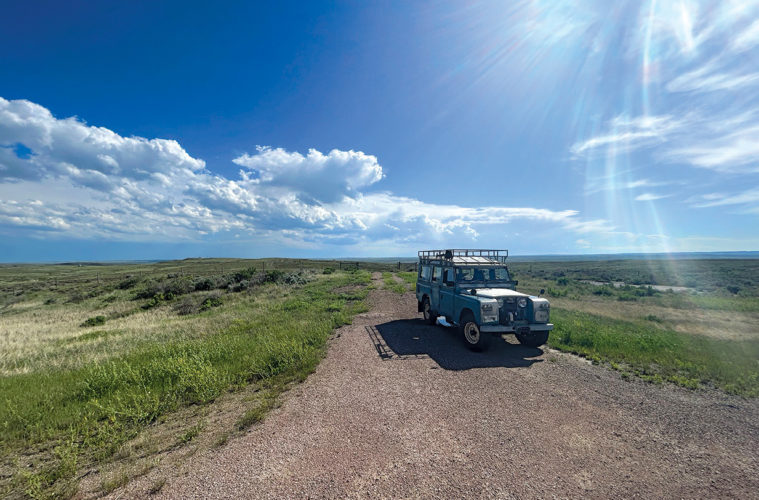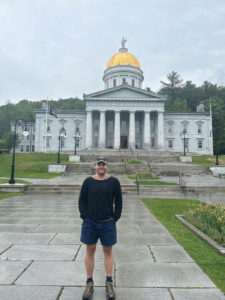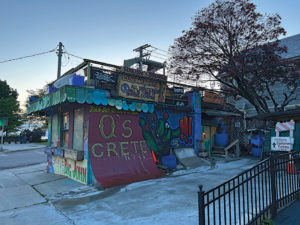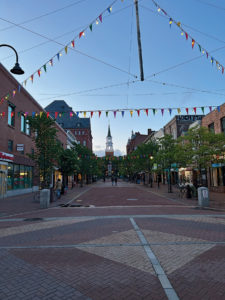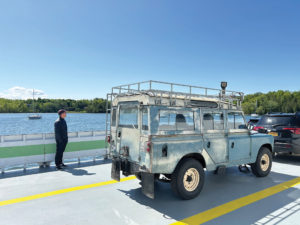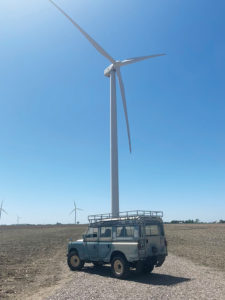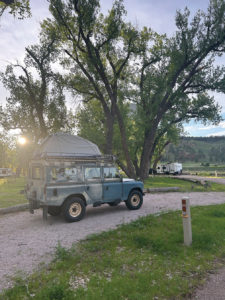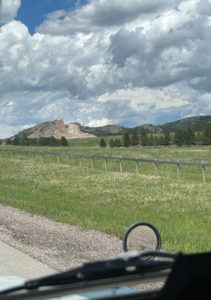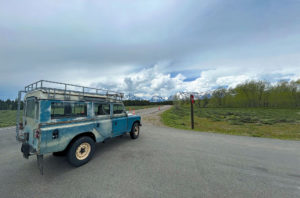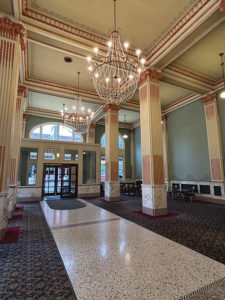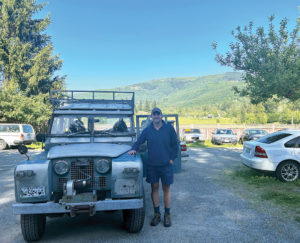Somewhere between Lincoln and Alliance, NE, my ’67 Series IIA 109” starts to bounce. It gives a distinct shudder as all systems take their final gulp of the finite lifeblood that fuels them. I’ve done it – I’ve run out of gas. With a broken fuel gauge, I’ve relied on time and distance since my last fill-up to decide to pull into whatever regional gas station dotted the roads of the Midwest. Now came the most satisfying wrench-turner moment of the entire cross-country trip.
I pull out a 5-liter jerrycan that I carryed in case of this exact moment. The “glug” of the gas pouring into the tank was the only manmade sound for miles. After running out of fuel in the middle of nowhere, I got out of it unscathed.
My Land Rover started life as a diesel on a farm in Vermont. It found a home at a cottage in Maine where it became a grocery-getter and lobster-roll fetcher for many years – which is how Matt Browne became involved with its care and maintenance. Jump forward to this summer and, thanks to Matt, I’m seeing my Land Rover for the first time in a year. I immediately fell in love – again – with its patina-blue beauty. As Matt rowed the gearshift on the drive back to his shop, it dawned on me that I would repeat those movements thousands of times over the next two weeks on my cross-country drive. Once in Matt’s shop, the sight of so many Land Rovers, each in a different stage of rebuild, was one of my coolest ever automotive experiences. I could have listened to Matt’s stories about each one for the entire day, but my good friend and neighbor, Mike Van Straaten, and I had big travel plans. For our first two days, we sought to make it to Burlington, VT, and then onward to Cleveland, OH. From there, I would continue solo to the West coast. Matt told us that news of our plans had trickled out online and that a small portion of the Land Rover community expressed doubts. Some predicted that we’d be lucky to make it to Albany, NY, 217 miles short of our destination along Lake Erie. Mike and I immediately set Albany as our marker of success — a small victory that we would have over the naysayers.
The first day of driving was loud and slow. As we crossed into Vermont, we were greeted with buckets of rain. I flipped the wiper switch on and the blades swung across the windshield at their one speed. Flipping a switch to activate anything in a car is a lost experience that is both functional and incredibly satisfying. There is something to be said about the tactile essence of the Rover; it’s an element of this automobile that I completely fall in love with again and again.
Water began to seep through in places, and the cabin welcomed a bit of nature. I pulled over in Montpelier, VT, to grab some duct tape and we patched up the leaks where we could. The truck continued to motor along and delivered us to our hotel in Burlington. We took in the sights and sloshed down a well-earned, ice-cold beer. Day two provided a crash course in cold starting. On a FaceTime with Matt, we learned that a bit of choke and adjustment of the hand throttle was the way to go (another manual process that made me feel like I was interacting with a real piece of machinery rather than a hop-in-and-go automobile).
Day two was the biggest day of them all. We crossed Lake Champlain on the ferry, drove across upstate NY, ticked Albany off the list, and hauled ass at 55 mph over 10 hours to Cleveland. My companion, Mike, and I grew up together and subsequently have spent a lot of time behind the wheel — whether driving to and from Whistler on the weekends or on the Coquihalla Highway in British Columbia during our first year of university together. I knew if there was one person I’d want with me on a long-haul drive, it was Mr. Van Straaten. He taught me how to drive stick shift in a mid-90s Pontiac Sunfire and enjoys an album front to back (the sweet sounds of Creedence Clearwater Revival as we cruised through Upstate New York never sounded better).
In Cleveland, Mike had to catch a flight home, so I now flew solo, although I knew that Matt would help with all things Rover. This instilled a sense of confidence in me that would come in handy throughout the trip. Armed with gas station cuisine (beef jerky, granola bars, 2L of water), I embarked on the back roads that author William Least Half Moon refers to as the “Blue Highways.” If you want to experience America as it was, as it is, and is it should always be, take these roads. The endless number of small towns connected by a long strip of road allows you to slow down and take it all in. At a gas station in McComb County, OH, I met a 70-year-old man named Carl. As I filled up the tank, he revealed to me that he hadn’t seen a Rover in the flesh in over 60 years, when he and his father would head up to Ontario’s Georgian Bay to a fishing lodge every summer. Gas stations in small towns like this would become the setting for many similar conversations. Just like with Carl — each conversation lit me up to see how the Rover jogged people’s memories and curiosity, and inspired their sense of adventure.
The history of these small Midwest towns became evident each time I passed a graveyard. Typically, the dates on the tombstones would go back to the mid-to-late 19th century. It was amazing to see the modern advertising, the advertising of yesteryear, the automobiles of today and the past, and how the years just seemed to pile up in these towns, layer after layer — you could see passing through how the times have changed, but these towns have held on to what they were founded on well over a hundred years ago.
I called it a day upon making it to Fort Wayne, Indiana. Immediately, Darius and Dave, two young parking attendants, greeted me saying that they’d never seen anything like a Land Rover before; they insisted that I park in the tenant lot for free! After asking my opinion on Toronto-born superstar, Drake (about whom I am quite indifferent), Darius excitedly told me that he wants to hit the road with no real destination in mind and do some exploring. A building tenant named Brian said to “Holler if anyone gives you any trouble,” and then asked to peer inside the 109”. Permission granted!
Heading into Illinois, favorable tailwinds made me feel like the Rover was sailing along. Once in Iowa, a sign enticed me to view the house used by painter Grant Wood for his 1930 classic, “American Gothic.” Eldon, IA, was a small as a small town could be, replete with dust roads and narrow, shady streets. The house wasn’t supposed to be grandiose; the setting wasn’t supposed to be earth-shatteringly beautiful — in my opinion, it acts as an ode to the tranquil yet uneasy nature of the American Midwest and the distinction of its space both culturally and physically from the rest of the world. I spent a bit of time investigating the structure — not as big, not as farmhouse-y as I had anticipated, but the banality of the two models who stood for Wood made complete sense now.
My first mechanical challenge arose after I filled up in Red Oak, IA. The Land Rover took its time coming back to life, so I hopped on an “e-Matt-gency” FaceTime and got under the hood. After going through our options, I took the relay box off and, much like a video game cartridge of yesteryear, I gave it a blow and gently plugged it back in. The fuel pump bubbled and let out a small but consistent whine — signaling that it was back from the dead.
I crossed the Missouri Rivers into Nebraska via a small, well-used and worn bridge, with a toll of only $2.00. I ascended a steep hill into the Cornhusker State. As I pulled into the small town of La Platte, I noticed a store dedicated to beef jerky. I pondered the potential flavors they had in stock that I’d never tried before, the type of character who ran the place, and the hours of delicious, dehydrated meat. After purchasing three new flavors, I went to start the Rover; to my dismay, no red light with the key turned “on.” I opened the hood and the man came out and offered a small toolset for me to use. Luckily, after digging out some melted plastic from the relay box with my pocketknife, the truck fired back up and I hit the road, vowing not to turn the car off again until I made it to Lincoln.
As with many midwestern towns I visited, Lincoln had an auto parts store on almost every corner. A very helpful tech at O’Reilly’s found three relay boxes – just what I needed! Minor issues like this one kept things interesting throughout the trip and highlighted the give-and-take relationship that one must have with a vehicle of this vintage. Every night, I’d survey Google Maps for my next day’s route, always avoiding highways and toll booths. I wanted to take roads that allowed me to travel at my own pace instead of keeping up with modern machines that move at modern speeds. There’s something special about not passing another car for half an hour at a time on these Blue Roads and giving a big wave out the window when you drive past another traveler. I imagine many of the cars that I crossed paths with must have also been perplexed by this antique rolling through at 50 MPH on remote backroads.
Driving through Nebraska, I felt the effects of the otherworldly atmosphere that roams the Midwest. Large, anvil-shaped clouds appeared on the horizon, with only a straight, flat piece of road between me and the storm ahead, featuring brutal headwinds, thunderstorms, marble-sized hail and torrential rains. As my road speed decreased, I wondered whether the Land Rover was being worked too hard, only to catch on that the wind was trying its hardest to push me backward. Nevertheless, the Rover got me to Alliance, NE, my overnight stop and the home of the famous “Carhenge” sculpture.
On the advice of East-West veterans, I headed to Custer, SD. Surrounded by the Black Hills National Forest and valleys rushing with rapids, I finally felt as though I had entered the Wild West. The main street included an outfitter where I found a tent, sleeping bag and mat. An ex-pat employee named Lauren shared that she had only recently relocated to Custer; she and her husband had many Land Rover stories to relate. She took a few deep inhales of the distinct gasoline smell that lingers in and around mine, climbed the ladder to look at the roof, then took a look at the two-piece windshield, which clearly held a certain place in her heart. People have a certain look on their faces when memories come rushing back that might have been hidden in their psyche; there is a joy in familiarity — even greeting an automobile after not seeing one of its kind in years brings a pure joy that the beholder can only relay to the listener. It’s almost as if my 109” was having a conversation with her and she was translating what it was saying to me.
I decided to drive up to see Mt. Rushmore; on my way up, I saw the much more impressive but incomplete bust of Crazy Horse. Set against the blue and purple sky — this was an “OMG” moment. Then came the 130-mile drive to Devil’s Tower. Passing through the plains of Wyoming, I saw my first pronghorn gazelle of the trip. As I gained and subsequently lost elevation, I dropped into a canyon where against the 7:00 pm sun, I saw the large rock formation protruding into the sky. To get a better look at the Tower, I drove all the way to its base. It stood, undisturbed and stoic as if it had been there since the beginning of time. The camping spot was surrounded by bison, longhorns and wolves, and a cacophony of birds sang in the trees above. With my camp set up and the sun setting, I concluded this was one of the most magical nights I’ve ever spent in nature.
I saw more curious creatures in the form of Mormon crickets; they resemble quarter-size, red dirt pebbles being pushed across the burning asphalt. Sniffing the air and staring at the road while fueling up, I realized that hundreds of thousands of them had spawned, been crushed by vehicles, fried under the sun, and now gave off a faintly food-market odor.
After a good night’s sleep in a Lander, WY, motor inn, I drove the 50 miles to enter the Wind River Reservation of the Shoshone and Arapaho tribal members. The spectacular flatlands turn into high plains that drop off into valleys on either side of the road. My idea of the American West has been built off of Jeremiah Johnson, City Slickers, Westworld (movie and show), John Mayer’s Paradise Valley album cover and Robert Service’s poetry (ok, Canadian) — the American West I got today was the one I have always imagined. I feel lucky to have experienced that dream in the flesh.
The Land Rover climbed up a mountain pass at 9,000 feet, slowly. Managing the way down, with its switchbacks and sweeping turns, required feathering the brakes, and matching gears with the throttle speed and clutch engagement. My right hand gripped the gearshift lever while my white-knuckled left clamped itself around the steering wheel. Similar ascents and descents would become a sport for a moment. Those passes would lead me to the Bridget Teton National Forest and into Yellowstone National Park – equally as mind-boggling. Together, they enabled me to pass through some of the continent’s most incredible nature.
The sight of a mid-2000s Corvette with British Columbia license plates gave me my first sense of proximity to my home region. I had family connections to Butte, MT (also the birthplace of Evil Knievel), so I stopped there for the night. Originally a mining town, it’s the home
of Montana State University and Montana Technological University, along with some private colleges. The crowd at Finlen’s Cavalier Lounge varied between university faculty and students, and locals who could remember when Anthony Bourdain filmed an episode of No Reservations at the nearby coffee shop. There is also a strong sense of community which gives the somewhat ghosty feel of this city an undeniable charm and warmth (although much of the arts scene has departed to the more prosperous Helena or Missoula).
While filling up in Missoula, a lady at the pump behind me told me that she’d driven an old Rover from England down to Spain. She also mentioned how badly she wanted to do it again and that seeing the Rover had ignited her desire to make another trip happen. Every gas station conversation I had filled me up with excitement to enjoy every aspect of this trip — to slow down (even slower than my average speed) and take in what I was doing. Traveling across some of the world’s most beautiful landscapes, seeing the heart of the United States and interacting with its people — showing them an automobile which, in many cases, they’d never seen the likes of — lit a spark of adventure in my heart and I’m sure in the hearts of those I chatted with.
I spent the night at a hotel on the outskirts of Spokane, Washington, and fueled up early next morning. My final day on the road lay ahead. The dry, desert-like landscape of Eastern Washington was unfamiliar to me but as I moved further and further West, the large cedar and pine trees and the impending coastline made me feel at home. Once I got through the brutal Seattle traffic and closer to Bellingham, WA, I saw the Pacific — definitely a sight for sore eyes and my marker that I’d completed the coast-to-coast voyage.
I’m grateful for my Land Rover, which provided me with the most immersive and meaningful life experiences. Thanks to Matt Browne and the legion of enthusiasts who followed my trek on social media; I’m eager for the next adventure.
